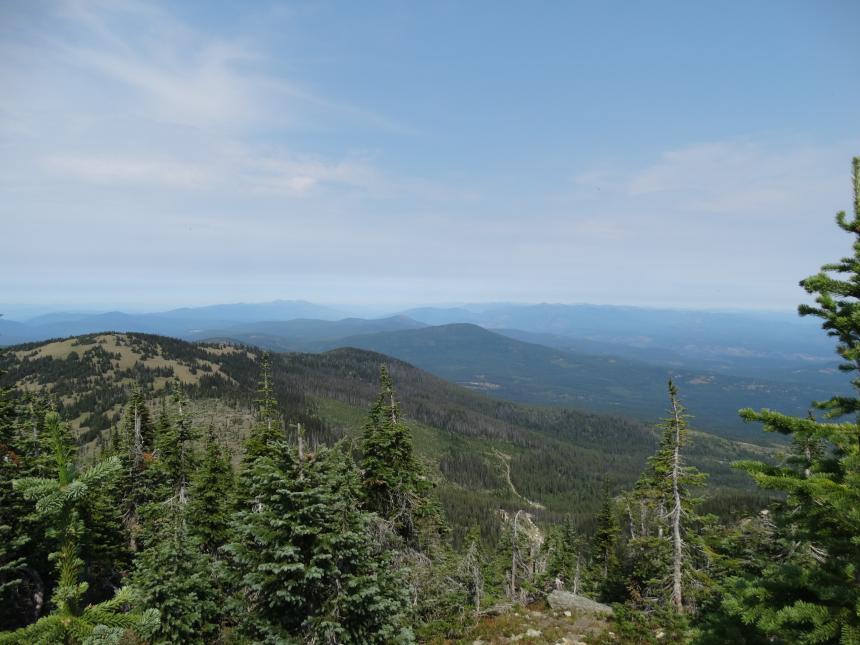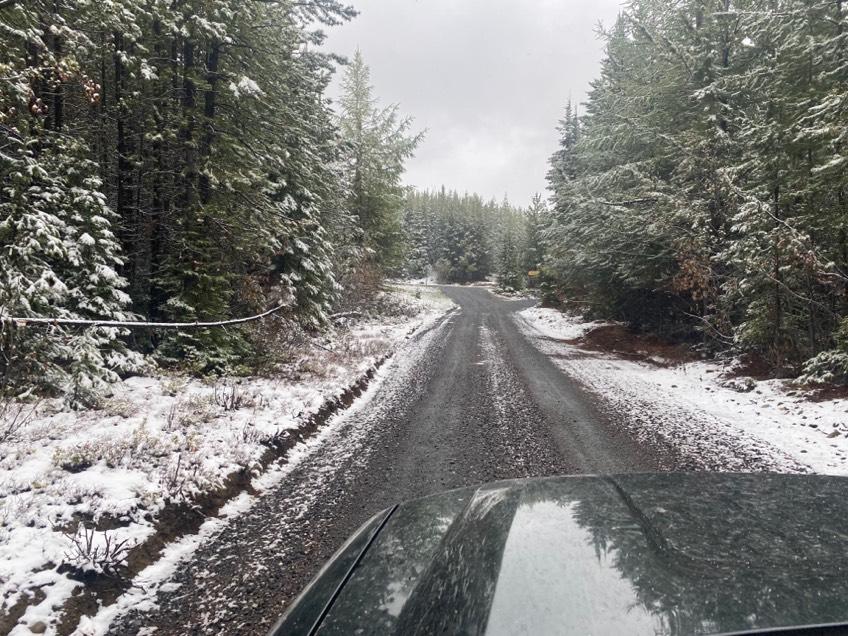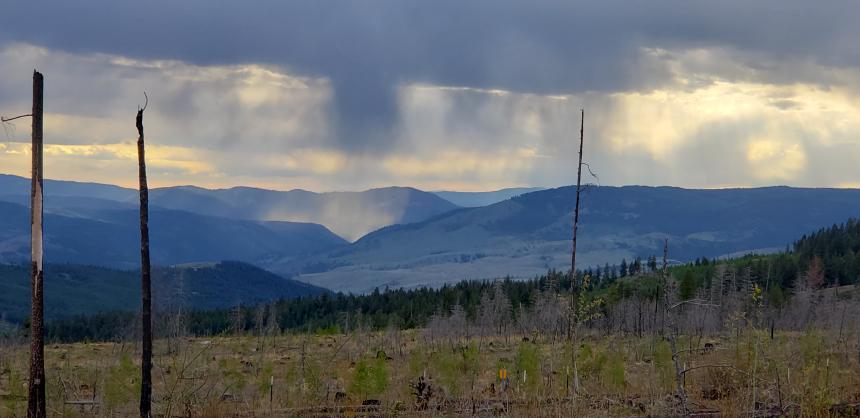This update provides an overview of gray wolf conservation and management activities in Washington during May 2021.
Program updates
No activity to report.
Communication and coordination
In northeast Washington, WDFW district staff are meeting with livestock producers and preparing conflict mitigation plans for areas currently defined as Special Focus Areas (PDF).
In southeast Washington, WDFW Wildlife Conflict Specialists spoke with the presidents of both the Columbia County and Walla Walla County Cattleman’s Associations. WDFW staff have met with numerous livestock producers to gather pertinent information about non-lethal, proactive, preventative measures. These meetings consisted of livestock producers from all four counties across the Blue Mountains (Walla Walla, Columbia, Garfield, and Asotin).
Wolf biologists presented the 2020 annual wolf update during a lunch seminar to WDFW and other agency staff.
Current population status and proactive conflict mitigation
The year-end minimum population count for 2020 was at least 132 known wolves in 24 known packs including at least 13 breeding pairs. The Confederated Tribes of the Colville Reservation reported 46 wolves in five packs. Annual wolf population surveys are conducted in the winter because wolf populations experience the least amount of natural fluctuation during this time. Counting the population at the end of each year allows for comparable year-to-year trends at a time of year when the wolf population is most stable. The year-end minimum population count for 2021 will be released in April 2022.
Reports of remote camera images or videos, wolf tracks, or sightings from the public are extremely helpful in locating previously undocumented wolf activity and potential new packs on the landscape. Please take photos of wolves or wolf sign (use some way to measure the size of a track) and upload them to the wolf reporting page via the following link: https://wdfw.wa.gov/species-habitats/at-risk/species-recovery/gray-wolf/observations
Definitions: A “pack” is defined as two or more wolves traveling together in winter, and a “breeding pair” is defined as at least one adult male and one adult female wolf that raised at least two pups that survived until December 31. In any given year, the number of packs will always be greater than or equal to the number of breeding pairs. The known territories and more information for each pack can be viewed by clicking the pack name.
Beaver Creek pack
No activity to report.
Butte Creek pack
No activity to report.
Carpenter Ridge pack
No activity to report.
Diobsud Creek pack
No activity to report.
Dirty Shirt pack
WDFW wolf biologists scouted this area for wolf activity this past month.

Goodman Meadows pack
No activity to report.
Grouse Flats pack
No activity to report.
Huckleberry pack
No activity to report.
Kettle pack
WDFW wolf biologists scouted this area for wolf activity this past month.

Leadpoint pack
No activity to report.
Lookout pack
No activity to report.
Loup Loup pack
No activity to report.
Naneum pack
On May 7, a livestock producer was performing regular livestock monitoring and range riding on private land in Kittitas county and noticed an injured calf. The calf was accompanied by its mother cow. WDFW staff investigated the calf and found numerous injuries mostly on the right rear leg and groin, as well as infection in the deeper puncture wounds. Staff estimated the injuries to be three to five days old. No injuries were observed on the adult cow.
WDFW staff who conducted the investigation made a determination of confirmed wolf depredation resulting in injuries because the nature and location of the injuries were consistent with wolf depredation, there were recent wolf locations in the area, and wolf tracks were observed at the location where the calf was discovered.
The affected livestock producer had several proactive, nonlethal deterrents in place, including calving away from areas occupied by wolves, delaying turnout of calves until calving is finished, removing sick/injured livestock from the pasture, using range riders and human presence around livestock, and carcass sanitation.
No attractants were observed or suspected at this location. Approximately three miles east, there is a large area where livestock carcasses have been illegally dumped along the southern boundary of the Naneum State Forest. WDFW has met with Department of Natural Resources staff and is actively working on potential outreach and solutions for this issue.
Sheep have been moved into the Naneum pack territory. A WDFW-contracted range rider is working in the area.
Navarre pack
WDFW wolf biologists captured, collared, and released an adult female wolf from the Navarre pack.
Onion Creek pack
No activity to report.
Salmo pack
No activity to report.
Sherman pack
No activity to report.
Skookum pack
No activity to report.
Smackout pack
No activity to report.
Stranger pack
Wolf biologists attempted to capture and collar a wolf in the Stranger pack, but were unsuccessful.
Strawberry pack
No activity to report.
Sullivan Creek pack
No activity to report.
Teanaway pack
WDFW wolf biologists scouted this area for wolf activity this past month. Cattle have been moved into the pack territory. A WDFW-contracted range rider is working in the area. In addition, an area producer has a range rider jointly funded by WDFW and Conservation Northwest covering a public grazing allotment.
Togo pack
WDFW wolf biologists captured, collared, and released an adult male wolf from the Togo pack.

Touchet pack
WDFW wolf biologists scouted this area for wolf activity this past month.
Tucannon pack
WDFW wolf biologists scouted this area for wolf activity this past month.
Vulcan pack
No activity to report.
Wedge pack
WDFW wolf biologists attempted to capture and collar a wolf in the Wedge pack but were unsuccessful. An adult female wolf was found dead in Wedge pack territory in May and it is currently under investigation.
Miscellaneous/lone wolves
WDFW wolf biologists worked with National Park Service biologists to check cameras in Stehekin in May looking for wolf activity. Biologists also placed cameras in areas south of I-90 scouting for wolf activity.
Note: The Frosty, Nason, Nc’icn, and Whitestone pack territories are within Confederated Tribes of the Colville Reservation (CTCR) lands and are managed under tribal authority. Information regarding these packs is proprietary and reported at the discretion of the CTCR.
Mortalities
On May 26, 2021, WDFW biologists and enforcement staff responded to a report of a dead wolf found in the Sheep Creek area of Stevens County. The investigation revealed the female wolf died as a result of a gunshot wound. Anyone who might have information regarding the incident is encouraged to call WDFW at 360-902-2928, visit the Department’s website by clicking on violations, or text WDFWTIP to 847411. Those who provide information leading to an arrest may be eligible for a cash reward or bonus points for special permit hunting opportunities. In addition, through a Memorandum of Understanding with WDFW, Conservation Northwest offers standing rewards for those who provide information that leads to a poaching conviction in Washington state under the following circumstances for wolves: up to $7,500 for information helping to convict anyone who has illegally killed a wolf in Washington. Reward funds are provided by Conservation Northwest’s members and donors.
As of this update, WDFW has documented three wolf mortalities in 2021.
Depredation activity
Please report any suspected livestock depredations or the death or harassment of wolves to the WDFW Enforcement Hotline at 1-877-933-9847.
In 2020, 76% of known wolf packs were not involved in any documented livestock depredation.
Below is a summary of packs with documented depredation activity within the past ten months (some packs have depredation history prior to the current ten-month window; this timeframe is considered based on guidance from the wolf-livestock interaction protocol (PDF)).
|
Pack |
Depredation date |
Depredation type |
Proactive non-lethals |
Ten-month window |
Agency lethal removal actions |
|
Beaver Creek |
8/21/20 |
Probable injury of calf |
Yes |
6/21/21 |
|
|
Leadpoint |
8/3/20 |
Confirmed mortality of calf (calf died from injuries) |
Yes |
6/3/21 |
|
|
|
8/7/20 |
Confirmed injury of calf |
Yes |
6/7/21 |
|
|
|
8/7/20 |
Confirmed injury of calf |
Yes |
6/7/21 |
|
|
|
8/7/20 |
Confirmed injury of calf |
Yes |
6/7/21 |
|
|
|
8/7/20 |
Confirmed kill of calf |
Yes |
6/7/21 |
|
|
|
8/10/20 |
Confirmed injury of calf |
Yes |
6/10/21 |
|
|
|
8/10/20 |
Confirmed kill of calf |
Yes |
6/10/21 |
|
|
|
8/14/20 |
Confirmed injury of calf |
Yes |
6/14/21 |
|
|
|
3/26/21 |
Probable injury of calf |
Yes |
1/26/22 |
|
|
Grouse Flats |
8/12/20 |
Probable injury of calf |
Yes |
6/12/21 |
|
|
Naneum |
5/7/21 |
Confirmed injury of calf |
Yes |
3/7/22 |
|
|
Smackout |
7/24/20 |
Confirmed kill of calf |
Yes |
5/24/21 |
|
|
Touchet |
1/16/21 |
Probable kill of calf |
No |
11/16/21 |
|
|
Wedge |
7/11/20 |
Confirmed injury of three calves |
Yes |
5/11/21 |
|
|
|
7/11/20 |
Confirmed injury of calf |
Yes |
5/11/21 |
|
|
|
7/11/20 |
Confirmed injury of calf |
Yes |
5/11/21 |
|
|
|
7/11/20 |
Confirmed injury of two calves |
Yes |
5/11/21 |
|
|
|
7/13/20 |
Confirmed injury of calf |
Yes |
5/13/21 |
|
|
|
7/25/20 |
Confirmed kill of calf and injury of calf |
Yes |
5/25/21 |
Adult female lethally removed 7/27/20 |
|
|
7/29/20 |
Probable kill of calf |
Yes |
5/29/21 |
|
|
|
7/29/20 |
Confirmed injury of two calves |
Yes |
5/29/21 |
|
|
|
7/30/20 |
Confirmed injury of two calves |
Yes |
5/30/21 |
|
|
|
7/31/20 |
Confirmed injury of two calves |
Yes |
5/31/21 |
|
|
|
7/31/20 |
Confirmed injury of calf |
Yes |
5/31/21 |
|
|
|
8/1/20 |
Confirmed injury of calf |
Yes |
6/1/21 |
Adult male and female lethally removed 8/13/20 |